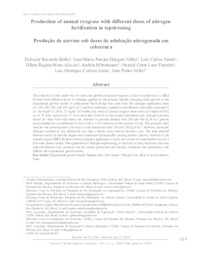Production of annual ryegrass with different doses of nitrogen fertilization in topdressing.
Production of annual ryegrass with different doses of nitrogen fertilization in topdressing.
Author(s): BOLKE, D. R.; HAYGERT-VELHO, I. M. P.; TIMM, L. C.; ALESSIO, D. R. M.; MITTELMANN, A.; FERREIRA, O. G. L.; LIMA, L. H. C.; VELHO, J. P.
Summary: The objective of this study was to assess the growth of annual ryegrass (Lolium multiflorum) cv. BRS Ponteio with different doses of nitrogen applied in the pasture, thereby adjusting their growth to the exponential growth model. A randomized block design was used with five nitrogen application rates (0, 150, 250, 350, and 450 kg N ha-1) and four replicates, applied in installments. Each plot measured 9 m2 . On April 15, 2014, 25 kg ha-1 of viable pure seeds of annual ryegrass were sown at a depth of 0.02 m, in 18 rows spaced at 0.17 m in each plot. Growth in the control treatment (zero nitrogen) pasture lasted 167 days with only three cuts, whereas in pastures treated with 350 and 450 kg N ha-1, growth was extended for an additional 45 days with a 333% increase in the number of cuts. The pastures were used for the same duration (188 days) in the treatments with 150 and 250 kg N ha-1, however, increased nitrogen resulted in two additional cuts and a shorter time interval between cuts. The time interval between each cut and the degree-days interacted dynamically causing distinct growth. Growth of the annual ryegrass BRS Ponteio without nitrogen application is poor and cannot be represented even by a first order linear model. The application of nitrogen topdressing, in the form of urea, decreases the time interval between cuts, increases the dry matter production per hectare, stimulates this production, and follows the exponential growth model.
Publication year: 2019
Types of publication: Journal article
Unit: Embrapa Dairy Cattle
Keywords: Degree-days, Dry matter, Exponential growth model, Rate of accumulation, Thermal sum, Urea
Observation
Some of Embrapa's publications are published as ePub files. To read them, use or download one of the following free software options to your computer or mobile device. Android: Google Play Books; IOS: iBooks; Windows and Linux: Calibre.
Access other publications
Access the Agricultural Research Database (BDPA) to consult Embrapa's full library collection and records.
Visit Embrapa Bookstore to purchase books and other publications sold by Embrapa.

